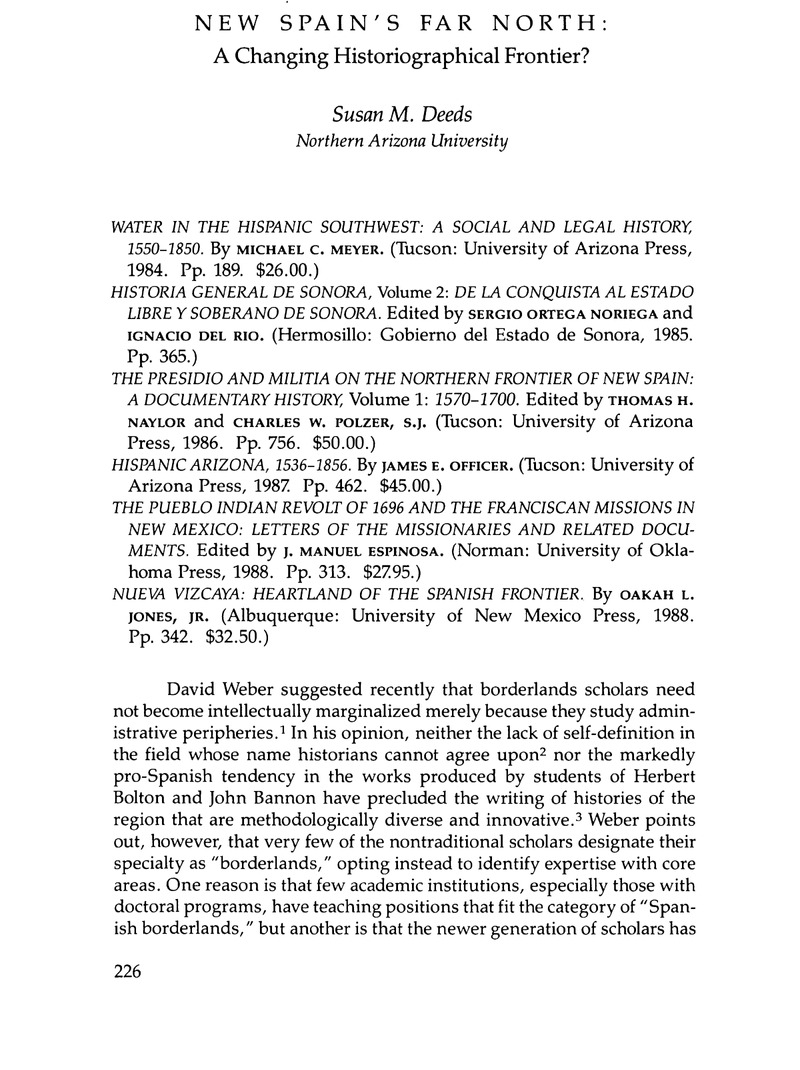No CrossRef data available.
Published online by Cambridge University Press: 12 October 2022

1. “John Francis Bannon and the Historiography of the Spanish Borderlands: Retrospect and Prospect,” Journal of the Southwest 29, no. 4 (Winter 1987):363. This perspective is reinforced by Thomas D. Hall in Social Change in the Southwest, 1350-1880 (Lawrence, Kan.: University Press of Kansas, 1989), which demonstrates how a peripheral area, in this case the “Greater Southwest,” provides an excellent arena for studying social change.
2. The disagreement centers on difficulties in spatial and temporal definition. The Spanish Borderlands, Western Borderlands, Eastern Borderlands, Greater Southwest, Hispanic Southwest, Arid America, U.S.-Mexico Borderlands, and New Spain's Far North all carry differing time and space delimiters.
3. See Weber, “John Francis Bannon,” 356–62.
4. This point was argued by José Cuello in “Beyond the ‘Borderlands’ Is the North of Colonial Mexico: A Latin Americanist Perspective to the Study of the Mexican North and the United States Southwest,” Proceedings of the Pacific Coast Council on Latin American Studies 9 (San Diego, Calif: San Diego State University Press, 1982). For a recent critique of the Bolton-Bannon school, see David Hurst Thomas, “Columbian Consequences: The Spanish Borderlands in Cubist Perspective,” in Columbian Consequences: Archaeological and Historical Perspectives on the Spanish Borderlands West, edited by David Hurst Thomas (Washington, D.C.: Smithsonian Institution, 1989), 1:1-14.
5. “Junípero Serra's Canonization and the Historical Record,” American Historical Review 93, no. 5 (Dec. 1988): 1253–69.
6. Among the exceptions are the works of Homer Aschmann, Sherburne F. Cook, Henry Dobyns, and Robert C. West.
7. Weber looks at the degree of incorporation of the region into the world economy in The Mexican Frontier, 1821–1846: The American Southwest under Mexico, 1821-1846 (Albuquerque: University of New Mexico Press, 1982). He has also examined the failure of borderlands historians to apply the Turner thesis to their subjects in “Turner, the Boltonians, and the Borderlands,” American Historical Review 91, no. 1 (Feb. 1986): 66–81. In Social Change in the Southwest, Hall explicitly tests the utility of world-systems theory in explaining the different trajectories of incorporation of nonstate societies by various states (Mesoamerican, Spanish, Mexican, and U.S.).
8. For more information on this project, the Documentary Relations of the Southwest, see Elizabeth A. H. John, “Crusading in the Hispanic Borderlands: An Essay Review,” Journal of the Southwest 30, no. 2 (Summer 1988):190-99.
9. This picture is also the one presented in the earlier study by Guillermo Porras Muñoz, La frontera con los indios de Nueva Vizcaya en el siglo XVII (Mexico City: Fomento Cultural Banamex, 1980).
10. In addition to the two editors who have contributed chapters, the authors are Ana María Atondo, Patricia Escandón, Edgardo López Mañón, Martha Ortega Soto, and Juan Domingo Vidargas del Moral.
11. For excellent examples of how Apache-Spanish relations in the borderlands can be presented as more than a chronicle of raiding and pillaging, see Hall, Social Change in the Southwest; and William B. Griffen, Apaches at War and Peace: The Janos Presidio, 1750-1858 (Albuquerque: University of New Mexico Press, 1988), and Utmost Good Faith: Patterns of Apache-Mexican Hostilities in Northern Chihuahua Border Warfare, 1821-1843 (Albuquerque: University of New Mexico Press, 1989).
12. For varying views on ethnohistorical methods, compare Thomas E. Sheridan, “How to Tell the Story of a People without History: Narrative versus Ethnohistorical Approaches to the Study of Yaqui Indians through Time,” Journal of the Southwest 30, no. 2 (Summer 1988); and Greg Dening, Islands and Beaches: Discourse on a Silent Land, Marquesas, 1774-1880 (Honolulu: University of Hawaii Press, 1980).
13. The colonial volume is accompanied by a profusion of charts, maps, and illustrations. Some of the background material on Spanish empire and conquest seems unsophisticated when compared to the sections on Sonoran history.
14. The bibliography for Nueva Vizcaya: Heartland of the Spanish Frontier contains no citations of works published after 1983, indicating an isolation from recent trends.
15. Oriental Despotism: A Comparative Study of Total Power (New Haven, Conn.: Yale University Press, 1957).
16. Donald Worster, Rivers of Empire: Water, Aridity, and the Growth of the American West (New York: Pantheon Books, 1985). Meyer's discomfort over the concept of water or environmental determinism perhaps explains his caution here.
17. See note 7.
18. See, for examples, Marvin Mikesell, “Comparative Studies in Frontier History,” Annals of the Association of American Geographers 50 (1960); Owen Lattimore, “The Frontier in History,” in Theory in Anthropology, edited by Robert A. Manners and David Kaplan (Chicago: Aldine, 1968); William H. McNeill, The Great Frontier: Freedom and Hierarchy in Modern Times (Princeton, N.J.: Princeton University Press, 1983); Alistair Hennessy, The Frontier in Latin American History (Albuquerque: University of New Mexico Press, 1978); and Leonard Thompson and Howard Lamar, “Comparative Frontier History,” in The Frontier in History, edited by Lamar and Thompson (New Haven, Conn.: Yale University Press, 1981).
19. For examples, see Robert McCaa, “Calidad, Clase, and Marriage in Colonial Mexico: The Case of Parral, 1788–1790,” Hispanic American Historical Review 64, no. 3 (1984): 477–501; and Deeds, “Rural Work in Nueva Vizcaya: Forms of Labor Coercion on the Periphery,” Hispanic American Historical Review, 69, no. 3 (1989):425-50.